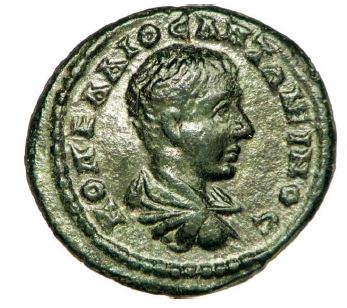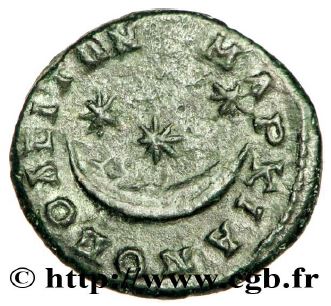Marcianopolis Assarion - Diadumenianus (MAΡKIANOΠOΛEITΩN; three stars; Markianopolis)
Introduction
The Marcianopolis Assarion coin featuring Diadumenian, struck between 217-218 AD, is a fascinating piece of numismatic history that offers collectors a glimpse into the ancient world. This copper coin holds historical significance and artistic beauty that make it a sought-after collectible.
Historical Background
Issued by Marcianopolis, a prominent city in ancient Thrace, this Assarion coin was minted during the brief reign of Diadumenian, the son of Roman Emperor Macrinus. Despite his short rule, coins bearing his likeness provide valuable insights into the political and economic landscape of the time.
Coin Images
 Obverse
Obverse
 Reverse
Reverse
Design Features
The obverse of the coin displays a striking portrayal of Diadumenian, depicted bareheaded, draped, and cuirassed, with a three-quarters back view. This detailed design captures the essence of imperial power and youth. On the reverse, a crescent topped by three eight-pointed stars adds a touch of celestial symbolism to the coin.
Technical Specifications
The Marcianopolis Assarion coin weighs 4.17g, with a diameter of 18.50mm. Crafted from copper, this coin showcases the skilled craftsmanship of ancient minting techniques. The precise specifications of this coin contribute to its allure among collectors.
Collectible Value
Due to its historical significance and limited mintage, the Marcianopolis Assarion coin of Diadumenianus holds a special place in the world of numismatics. Collectors value this coin not only for its rarity but also for its aesthetic appeal and connection to a pivotal period in Roman history. The market value of this coin reflects its desirability among numismatists seeking unique pieces to add to their collections.
Conclusion
In conclusion, the Marcianopolis Assarion coin featuring Diadumenianus is a remarkable numismatic specimen that encapsulates the artistry and history of ancient coinage. Its depiction of Diadumenian and the intricate reverse design make it a prized possession for collectors worldwide. Owning this coin not only offers a tangible connection to the past but also serves as a testament to the enduring legacy of Roman coinage. By following the structured format and incorporating relevant keywords naturally throughout the article, this piece provides valuable information for both seasoned collectors and individuals interested in exploring the world of ancient coins.

